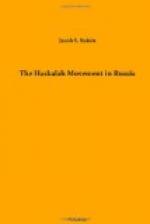From the South had come the impulse of religious revivalism through the followers of the Besht, and the North was showing signs of awakening through the reforms of the Gaon. At the same time a ray of enlightenment from the West pierced through the night. To make the regeneration of Slavonic Judaism complete, the element of estheticism had to be added to emotionalism and reason. From the warm South came Besht, from the studious North Hagra, and Rambman (Mendelssohn) made his appearance from the enlightened West. The triumvirate was complete.
Not that Mendelssohn ever visited or resided in Russo-Poland. But the gentle, cultured little savant of Berlin, with whose lips, Carlyle tells us, Socrates spoke like Socrates in German as in no other modern language, “for his own character was Socratic,” was at no period of his life wholly cut off from influencing Slavonic Jews and from being influenced by them. As a lad Mendelssohn was instructed by Israel Moses Halevi of Zamoscz (ab. 1700-1772). This teacher of his, who is credited with several inventions, and of whom Lessing says, in a letter to Mendelssohn, that he was “one of the first to arouse a love for science in the hearts of Jews,” imbued him with love for philosophy. When Mendelssohn emerged from obscurity, and, despite ill-health and ignorance, attained culture and breeding, his associate, who was with him the most important factor in German Haskalah, was the renowned Naphtali, or Hartwig, Wessely, whose grandfather Joseph Reis had been among the fugitives from the Cossack massacres in 1648. And when he became famous, and took his place among the greatest of his age, he still sought diversion and instruction among the Slavonian Jews, and boasted of being a descendant of one of them, Moses Isserles of Cracow. As formerly with the Talmud, the Haskalah seemed, at the time of Mendelssohn, to be moving from the East westward, through the agency of the Slavonic Jews pouring perennially into Germany. Positions, from the lowly melammed’s to the honorable chief rabbi’s in prominent communities, were filled almost exclusively by them. The cause of Judaism seems to have been entrusted to them. Ezekiel Landau, whose tactful intercession helped greatly to establish peace between the Emden-Eybeschuetz factions, was rabbi of Prague for almost forty years




